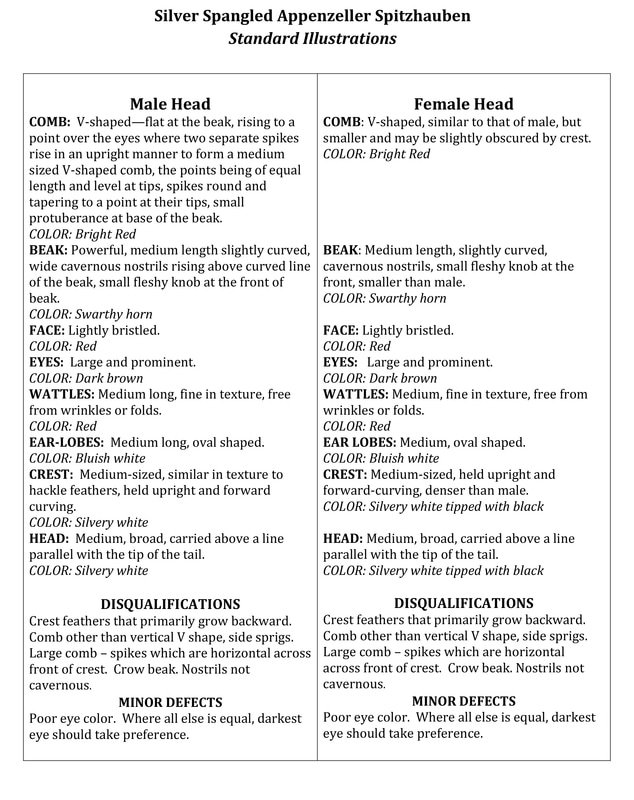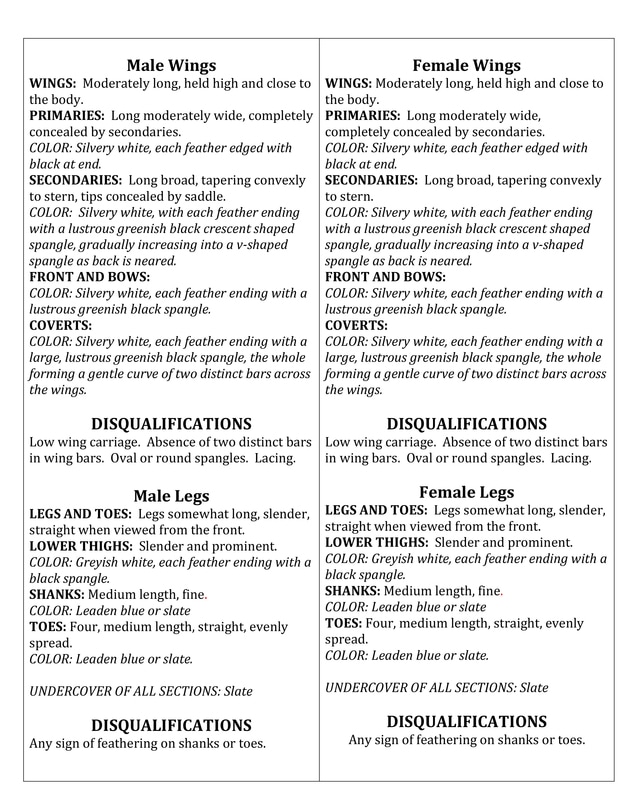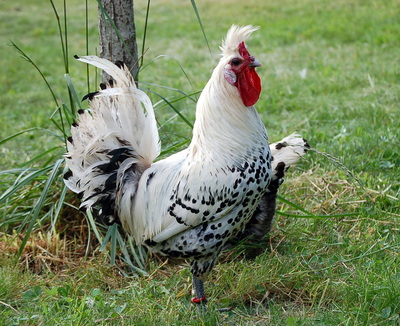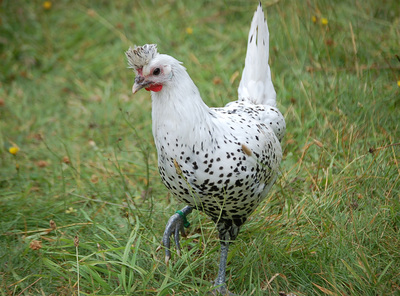Use the UK Standard below as a guideline for colors other than silver spangled.
These are the current UK standards for the Spitzhauben.
These are the current UK standards for the Spitzhauben.
Classification: Light, Soft Feather
Egg colour: White
General Characteristics: Male
Carriage: Neat and very active
Type: Breast full and well rounded, carried high. Body medium long, tapering towards the tail (walnut-shaped). Abdomen well developed. Back of medium length, slightly sloping with full hackle.
Wings rather long, carried close. Tail well furnished, well spread, carried high, but by no means a squirrel tail.
Head: Medium sized, held high, with typical raised skull. Medium-sized, forward-pointing crest held tight and compact with no inclination towards looseness or globular shape. Face smooth. Comb horn type consisting of two small rounded, vertical spikes, separate and without side sprigs. Wattles moderately long and fine, free from folds. Ear-lobes medium sized, oval. Beak powerful, with strong, cavernous nostrils, and a prominent horseshoe ridge to beak with a small fleshy knob at the front. Eyes prominent and alert.
Neck: Medium length, slightly arched with abundant hackle.
Legs and feet: Thighs slender and prominent; shanks medium length, fine. Toes, four, well spread.
Plumage: Fairly hard and tight.
Female
General handling as befits a keen and active layer. Except for a more horizontal back line the general characteristics are the same for the male, allowing for the natural sexual differences.
Colour
Silver Spangled
Male plumage: Pure silvery white ground colour, with each feather ending in distinct black spangle free from an outer lacing of silvery white. The more V shaped the spangle the better with no inclination to lacing or circular shape. Spangling to be uniformly spread, fairly small so as to be surrounded as evenly as possible with silvery white ground colour. Less pronounced on the head and neck. Wing bow to be spangled evenly as on the body and forming two distinct and parallel bars running with a gentle curve across each wing.
Primaries and secondaries, silvery white each feather ending with a black spangle. Tail pure silvery white, ending with a defined spangle, as free as possible from any black/grey sootiness. Abdomen and fluff grey; undercolour dark grey.
Female plumage: Head, crest and the neck silvery white with black spangling. Breast, wing bows, primaries, secondaries, back and tail silvery white with distinct black spangling as for the male. Undercolour dark grey.
Gold Spangled
Male plumage: Gold-red ground colour, spangling as for the silver spangled. Primaries and secondaries Gold-red each feather ending with a black spangle. Breast and flanks gold with black spangles. Abdomen and undercolour greyish black. Tail gold-red, ending with a defined spangle, as free as possible from any black/grey sootiness is the ideal. A gold-red/blackish tail is permissible. The specimen with the least sootiness to be given the award where all else is equal.
Female plumage: Head, crest and the neck golden-red with black spangling. Flights, Breast, wing bows, back and tail golden-red with distinct black spangling as for the male. Undercolour dark grey.
Black
Male and female plumage: Black with lustrous beetle-green sheen throughout. Perfectly free from any other colour. Undercolour dark grey to black.
Blue
Male plumage: Head, neck, saddle and wing-bows dark slate-blue. Remainder medium blue (pigeon blue preferred). Free from: lacing, mealiness, sandiness or bronze. Undercolour grey-blue .
Female plumage: Medium blue (pigeon blue preferred) throughout. Free from: lacing, mealiness, sandiness or bronze. A darker shade on the head and neck is permissible, but preference should always be given to those examples which are a uniform shade throughout. Undercolour grey-blue.
Chamois Spangled
Male plumage: Golden-buff ground colour, creamy-white spangling as for the silver spangled. Uniform shade of Golden-buff throughout allowing for the lustre on the wing bows, hackle and saddle of the male. Where all else is equal and definition of spangle is maintained from the ground colour the exhibit with the lighter shade to take the award.
Flights; golden-buff ending with a creamy-white spangle. Breast and flanks golden-buff with creamy-white spangles. Abdomen and undercolour creamy-white. Tail golden-buff, ending with a defined spangle, as free as possible from any creamy-white sootiness is the ideal. A golden-buff/ creamy-whiteish tail is permissible. The specimen with the least sootiness to be given the award where all else is equal.
Female plumage: Head, crest and the neck golden-buff with creamy-white spangling. Flights; golden-buff ending with a creamy-white spangle. Breast, wing bows, back and tail golden-buff with distinct creamy-white spangling as for the male. Undercolour creamy-white.
In both sexes and all colours
Beak bluish. Eyes dark brown. Comb, face and wattles bright red; ear-lobes bluish-white. Shanks blue.
Bantams
Bantams should follow the large fowl standard in all aspects apart from the size/weight difference.
Weights (Large Fowl)
Male 1.60 - 2.00kg (3.5 - 4.5 lb)
Female 1.35 - 1.60kg (3 - 3.5 lb)
Weights (bantams)
Male: 600 – 800 grams (21 – 28oz)
Female: 500 – 700 grams (17 – 24oz)
Minor defects
Poor eye colour, where all else is equal darkest eye should take preference.
Serious defects
Comb other than vertical horn. Side sprigs. Large comb – horns which are horizontal across front of crest. Narrow or roach back. Squirrel tail. Breast too deep or narrow. Low wing carriage. Tail lacking fullness. Crow beak. Nostrils not cavernous. Bad stance. Any sign of feathering on shanks.
Egg colour: White
General Characteristics: Male
Carriage: Neat and very active
Type: Breast full and well rounded, carried high. Body medium long, tapering towards the tail (walnut-shaped). Abdomen well developed. Back of medium length, slightly sloping with full hackle.
Wings rather long, carried close. Tail well furnished, well spread, carried high, but by no means a squirrel tail.
Head: Medium sized, held high, with typical raised skull. Medium-sized, forward-pointing crest held tight and compact with no inclination towards looseness or globular shape. Face smooth. Comb horn type consisting of two small rounded, vertical spikes, separate and without side sprigs. Wattles moderately long and fine, free from folds. Ear-lobes medium sized, oval. Beak powerful, with strong, cavernous nostrils, and a prominent horseshoe ridge to beak with a small fleshy knob at the front. Eyes prominent and alert.
Neck: Medium length, slightly arched with abundant hackle.
Legs and feet: Thighs slender and prominent; shanks medium length, fine. Toes, four, well spread.
Plumage: Fairly hard and tight.
Female
General handling as befits a keen and active layer. Except for a more horizontal back line the general characteristics are the same for the male, allowing for the natural sexual differences.
Colour
Silver Spangled
Male plumage: Pure silvery white ground colour, with each feather ending in distinct black spangle free from an outer lacing of silvery white. The more V shaped the spangle the better with no inclination to lacing or circular shape. Spangling to be uniformly spread, fairly small so as to be surrounded as evenly as possible with silvery white ground colour. Less pronounced on the head and neck. Wing bow to be spangled evenly as on the body and forming two distinct and parallel bars running with a gentle curve across each wing.
Primaries and secondaries, silvery white each feather ending with a black spangle. Tail pure silvery white, ending with a defined spangle, as free as possible from any black/grey sootiness. Abdomen and fluff grey; undercolour dark grey.
Female plumage: Head, crest and the neck silvery white with black spangling. Breast, wing bows, primaries, secondaries, back and tail silvery white with distinct black spangling as for the male. Undercolour dark grey.
Gold Spangled
Male plumage: Gold-red ground colour, spangling as for the silver spangled. Primaries and secondaries Gold-red each feather ending with a black spangle. Breast and flanks gold with black spangles. Abdomen and undercolour greyish black. Tail gold-red, ending with a defined spangle, as free as possible from any black/grey sootiness is the ideal. A gold-red/blackish tail is permissible. The specimen with the least sootiness to be given the award where all else is equal.
Female plumage: Head, crest and the neck golden-red with black spangling. Flights, Breast, wing bows, back and tail golden-red with distinct black spangling as for the male. Undercolour dark grey.
Black
Male and female plumage: Black with lustrous beetle-green sheen throughout. Perfectly free from any other colour. Undercolour dark grey to black.
Blue
Male plumage: Head, neck, saddle and wing-bows dark slate-blue. Remainder medium blue (pigeon blue preferred). Free from: lacing, mealiness, sandiness or bronze. Undercolour grey-blue .
Female plumage: Medium blue (pigeon blue preferred) throughout. Free from: lacing, mealiness, sandiness or bronze. A darker shade on the head and neck is permissible, but preference should always be given to those examples which are a uniform shade throughout. Undercolour grey-blue.
Chamois Spangled
Male plumage: Golden-buff ground colour, creamy-white spangling as for the silver spangled. Uniform shade of Golden-buff throughout allowing for the lustre on the wing bows, hackle and saddle of the male. Where all else is equal and definition of spangle is maintained from the ground colour the exhibit with the lighter shade to take the award.
Flights; golden-buff ending with a creamy-white spangle. Breast and flanks golden-buff with creamy-white spangles. Abdomen and undercolour creamy-white. Tail golden-buff, ending with a defined spangle, as free as possible from any creamy-white sootiness is the ideal. A golden-buff/ creamy-whiteish tail is permissible. The specimen with the least sootiness to be given the award where all else is equal.
Female plumage: Head, crest and the neck golden-buff with creamy-white spangling. Flights; golden-buff ending with a creamy-white spangle. Breast, wing bows, back and tail golden-buff with distinct creamy-white spangling as for the male. Undercolour creamy-white.
In both sexes and all colours
Beak bluish. Eyes dark brown. Comb, face and wattles bright red; ear-lobes bluish-white. Shanks blue.
Bantams
Bantams should follow the large fowl standard in all aspects apart from the size/weight difference.
Weights (Large Fowl)
Male 1.60 - 2.00kg (3.5 - 4.5 lb)
Female 1.35 - 1.60kg (3 - 3.5 lb)
Weights (bantams)
Male: 600 – 800 grams (21 – 28oz)
Female: 500 – 700 grams (17 – 24oz)
Minor defects
Poor eye colour, where all else is equal darkest eye should take preference.
Serious defects
Comb other than vertical horn. Side sprigs. Large comb – horns which are horizontal across front of crest. Narrow or roach back. Squirrel tail. Breast too deep or narrow. Low wing carriage. Tail lacking fullness. Crow beak. Nostrils not cavernous. Bad stance. Any sign of feathering on shanks.
| Type and Carriage | 25 |
| Definition, Clarity & Evenness of Spangles | 15 |
| Purity of ground colour | 10 |
| Crest | 20 |
| Head, Comb & Wattles | 10 |
| Legs & Feet | 10 |
| Condition | 10 |
| Total | 100 |
| Type and Carriage | 25 |
| Colour | 25 |
| Crest | 20 |
| Head, Comb & Wattles | 10 |
| Legs & Feet | 10 |
| Condition | 10 |
| Total | 100 |






